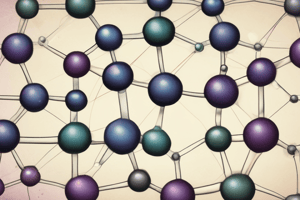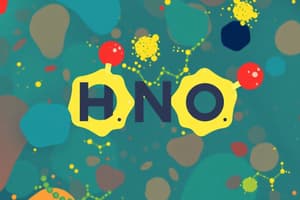Podcast
Questions and Answers
What is a heterocyclic compound?
What is a heterocyclic compound?
A heterocyclic compound is one that contains a ring made up of more than one kind of atom.
Define aromaticity in organic chemistry.
Define aromaticity in organic chemistry.
Aromaticity is a property of conjugated cycloalkenes that enhances molecule stability due to delocalization of electrons in pi orbitals.
What is the Huckel 4n+2 rule related to aromaticity?
What is the Huckel 4n+2 rule related to aromaticity?
The Huckel 4n+2 rule is a criterion for aromaticity stating that the number of pi electrons in a cyclic system must follow the formula 4n+2 to exhibit aromatic properties.
What is the condition for aromaticity related to the atoms in the ring?
What is the condition for aromaticity related to the atoms in the ring?
What is the condition for a molecule to be capable of aromaticity?
What is the condition for a molecule to be capable of aromaticity?
How many pi electrons does a molecule need to exhibit aromaticity?
How many pi electrons does a molecule need to exhibit aromaticity?
What is the 'magic series' for pi electrons in relation to aromaticity?
What is the 'magic series' for pi electrons in relation to aromaticity?
What does the formula [4n+2] represent in the context of aromaticity?
What does the formula [4n+2] represent in the context of aromaticity?
What is the condition called when aromatic molecules must have [4n+2] pi electrons?
What is the condition called when aromatic molecules must have [4n+2] pi electrons?
How many pi electrons does the cyclopentadiene anion have?
How many pi electrons does the cyclopentadiene anion have?
What is the fourth condition for aromaticity?
What is the fourth condition for aromaticity?
Give an example of a heterocyclic compound mentioned in the text.
Give an example of a heterocyclic compound mentioned in the text.
What are some examples of heterocycles that are fundamental to life?
What are some examples of heterocycles that are fundamental to life?
What are some examples of biologically active pyridine or piperidine derivatives mentioned in the text?
What are some examples of biologically active pyridine or piperidine derivatives mentioned in the text?
What are the three simplest five-membered heterocyclic compounds mentioned in the text?
What are the three simplest five-membered heterocyclic compounds mentioned in the text?
Why do pyrrole, furan, and thiophene not exhibit the properties expected based on their structures?
Why do pyrrole, furan, and thiophene not exhibit the properties expected based on their structures?
What is the significance of having an available p orbital in every atom around the ring for aromaticity?
What is the significance of having an available p orbital in every atom around the ring for aromaticity?
Explain the concept of the 'magic series' in relation to the number of pi electrons for aromaticity.
Explain the concept of the 'magic series' in relation to the number of pi electrons for aromaticity.
Distinguish between benzene and cyclooctatetraene in terms of their pi electron count and aromaticity.
Distinguish between benzene and cyclooctatetraene in terms of their pi electron count and aromaticity.
What is the purpose of the formula [4n+2] in the context of aromaticity?
What is the purpose of the formula [4n+2] in the context of aromaticity?
What is the difference between homocyclic and heterocyclic compounds?
What is the difference between homocyclic and heterocyclic compounds?
How is aromaticity defined in organic chemistry?
How is aromaticity defined in organic chemistry?
Explain the condition for a molecule to exhibit aromaticity related to the atoms in the ring.
Explain the condition for a molecule to exhibit aromaticity related to the atoms in the ring.
What are some characteristics of aromatic compounds and how do they differ from aliphatic compounds?
What are some characteristics of aromatic compounds and how do they differ from aliphatic compounds?
What is Hückel's rule and how is it related to aromaticity?
What is Hückel's rule and how is it related to aromaticity?
Explain the significance of a molecule needing to be flat for aromaticity.
Explain the significance of a molecule needing to be flat for aromaticity.
Why are heterocyclic compounds important in the biological world?
Why are heterocyclic compounds important in the biological world?
Discuss the role of pi electrons in determining aromaticity in organic compounds.
Discuss the role of pi electrons in determining aromaticity in organic compounds.
Explain why pyrrole, furan, and thiophene are considered aromatic based on the text.
Explain why pyrrole, furan, and thiophene are considered aromatic based on the text.
Describe the orbital picture of pyrrole and explain how it contributes to its aromaticity.
Describe the orbital picture of pyrrole and explain how it contributes to its aromaticity.
What is the significance of the heat of combustion values in determining the aromaticity of pyrrole, furan, and thiophene?
What is the significance of the heat of combustion values in determining the aromaticity of pyrrole, furan, and thiophene?
Explain how the delocalization of π electrons in pyrrole contributes to its stability and reactivity.
Explain how the delocalization of π electrons in pyrrole contributes to its stability and reactivity.
What defines aromaticity in organic compounds and why is it significant?
What defines aromaticity in organic compounds and why is it significant?
Explain the significance of the continuous ring of p-orbitals and the 'pi system' in relation to aromaticity.
Explain the significance of the continuous ring of p-orbitals and the 'pi system' in relation to aromaticity.
What characterizes heterocyclic compounds and how do they differ from homocyclic compounds?
What characterizes heterocyclic compounds and how do they differ from homocyclic compounds?
Explain the significance of the 'magic series' [4n+2] in relation to aromaticity.
Explain the significance of the 'magic series' [4n+2] in relation to aromaticity.
Discuss the significance of the Huckel 4n+2 rule in determining aromaticity and stability.
Discuss the significance of the Huckel 4n+2 rule in determining aromaticity and stability.
Describe the conditions required for a molecule to exhibit aromaticity based on the text.
Describe the conditions required for a molecule to exhibit aromaticity based on the text.
Discuss the difference between benzene and cyclooctatetraene in terms of their aromaticity and pi electron count.
Discuss the difference between benzene and cyclooctatetraene in terms of their aromaticity and pi electron count.
Explain the role of available p orbitals in every atom around the ring for aromaticity.
Explain the role of available p orbitals in every atom around the ring for aromaticity.
What are the properties of pyrrole, furan, and thiophene that make them unique compared to what is expected based on their structures?
What are the properties of pyrrole, furan, and thiophene that make them unique compared to what is expected based on their structures?
Why do pyrrole, furan, and thiophene not demonstrate the usual chemical properties of amines, ethers, or sulfides despite containing nitrogen, oxygen, or sulfur atoms?
Why do pyrrole, furan, and thiophene not demonstrate the usual chemical properties of amines, ethers, or sulfides despite containing nitrogen, oxygen, or sulfur atoms?
What makes pyridine and piperidine derivatives mentioned in the text significant in the context of biologically active compounds?
What makes pyridine and piperidine derivatives mentioned in the text significant in the context of biologically active compounds?
How do pyrrole, furan, and thiophene differ from the expected properties of a conjugated diene and an amine, ether, or sulfide?
How do pyrrole, furan, and thiophene differ from the expected properties of a conjugated diene and an amine, ether, or sulfide?
Explain why pyrrole is an extremely weak base and highly reactive towards electrophilic substitution.
Explain why pyrrole is an extremely weak base and highly reactive towards electrophilic substitution.
Describe the main reason for the study of pyrrole and its connection to haem and chlorophyll.
Describe the main reason for the study of pyrrole and its connection to haem and chlorophyll.
Explain the structural similarities and differences between pyrrole, furan, and thiophene in terms of the atoms carrying unshared pairs of electrons.
Explain the structural similarities and differences between pyrrole, furan, and thiophene in terms of the atoms carrying unshared pairs of electrons.
Discuss the origin of unsubstituted pyrrole, furan, and thiophene and their general characteristics.
Discuss the origin of unsubstituted pyrrole, furan, and thiophene and their general characteristics.
Flashcards are hidden until you start studying
Study Notes
Heterocyclic Compounds and Aromaticity
- A heterocyclic compound is a cyclic compound that contains atoms of at least two different elements, one of which is carbon.
- Aromaticity in organic chemistry is a property of conjugated ring systems that exhibit extraordinary stability and characteristic chemical properties.
Huckel's Rule and Aromaticity
- Huckel's rule states that a planar, monocyclic, and fully conjugated ring system with [4n+2] pi electrons is aromatic.
- The [4n+2] rule is a condition for aromaticity, where n is an integer.
- A molecule must have [4n+2] pi electrons to exhibit aromaticity, which is known as the 'magic series'.
Conditions for Aromaticity
- For a molecule to be capable of aromaticity, it must be planar, monocyclic, and fully conjugated.
- The atoms in the ring must have an available p orbital for delocalization of pi electrons.
- The molecule must have [4n+2] pi electrons.
Examples of Heterocyclic Compounds
- Pyrrole is an example of a heterocyclic compound mentioned in the text.
- Pyridine and piperidine derivatives are biologically active heterocycles.
- Furan and thiophene are also examples of heterocycles that are fundamental to life.
Characteristics of Aromatic Compounds
- Aromatic compounds exhibit extraordinary stability and characteristic chemical properties.
- They differ from aliphatic compounds in terms of their planar, monocyclic, and fully conjugated ring systems.
- Aromatic compounds have [4n+2] pi electrons, which is a condition for aromaticity.
Importance of Heterocyclic Compounds
- Heterocyclic compounds are important in the biological world due to their unique properties and wide occurrence in natural products.
- They play a crucial role in many biological processes and are used as building blocks for many biologically active compounds.
Pi Electrons and Aromaticity
- Pi electrons play a crucial role in determining aromaticity in organic compounds.
- The delocalization of pi electrons in a planar, monocyclic, and fully conjugated ring system leads to aromaticity.
- The 'magic series' [4n+2] represents the number of pi electrons required for aromaticity.
Studying That Suits You
Use AI to generate personalized quizzes and flashcards to suit your learning preferences.




